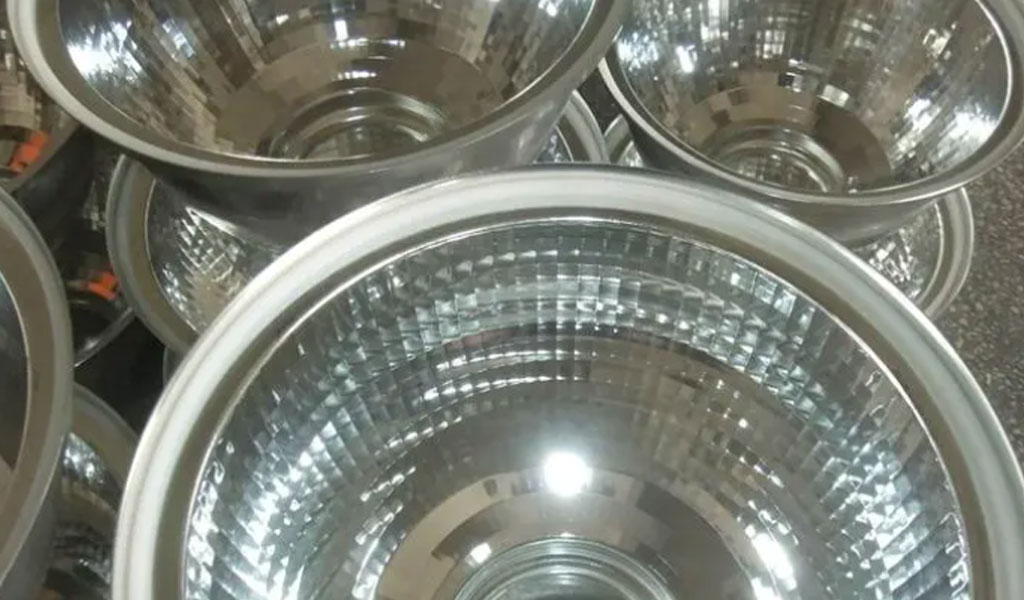The thin-walled rotary shell components manufactured by spin forming technology solve the technical problems such as low rigidity, large vibration, low processing accuracy or technical problems that cannot be processed at all during turning processing, and have many advantages in the aerospace field. Stainless steel spinning
The φ3900mm large-scale missile casing produced by American Power Spinning has a radial dimension accuracy of 0.05mm, a surface roughness Ra of 1.6~3.2μm, and a wall thickness difference of ≤0.03mm. American Titanium Manufacturing Company uses a 1.5m vertical spinning machine to spin the φ1524mm Ti-6Al-4V titanium alloy missile pressure vessel head, and the spinning time for each head is 5min. The second-stage solid motor casing of the Minuteman intercontinental missile is made of Ti-6Al-4V titanium alloy, which is formed by powerful spinning. The weight of the formed titanium alloy casing is reduced by 30%. Focusing on the requirements of aerospace models for lightweight, high-strength, and large-scale aerospace, MT Aerospace of Germany used the spinning process to prepare a φ1905mm high-strength Ti-15V-3Cr alloy propulsion system storage tank, and applied it to the giant platform of the European Alpha communication satellite, realizing the Substantial weight reduction and increased payload of the satellite platform.
The research on spinning technology and equipment in my country originated in the early 1960s, and the research on spinning titanium alloys began in the 1970s. After more than 40 years of development, a mature system from equipment research to process development has basically been formed. . Titanium alloys and spinning products used in domestic aerospace, such as rocket engine shells, blade covers, gyroscope guide covers, inner skins, etc. Ti8Al1Mo1V high titanium alloys are used for heat treatment of engine blades to strengthen titanium alloy spinning; TB2 titanium alloys are used for small spray Tube spinning etc.
Xi’an Aerospace Power Machinery Factory has developed the titanium alloy cylindrical part with the largest diameter in China; it has successfully spun out a φ500mm thin-walled semicircular titanium ring through two forward and reverse general turning flanging, and the parts are used for micro-dynamic attitude adjustment of space vehicles.
The 703rd Research Institute of China Aerospace Science and Technology Corporation adopts the technology of combining general rotation and strong rotation, and uses TC3 and TC42 titanium alloy plates as blanks to prepare two kinds of titanium alloy hemispherical (522mm×2.0mm inside φ) by hot spinning. ), cylindrical storage tank shell (cup-shaped piece of φ163mm×2.0mm×200mm, cylindrical piece of φ163mm×2.0mm×360mm and φ112mm×6.0mm×1000mm).
In recent years, with the development of computer simulation technology, numerical simulation has been widely used in the analysis of metal parts spinning forming process. The Institute of Aerospace Materials and Technology conducted computer simulations on TC4 cylindrical parts, analyzed the influence of process parameters such as the angle of attack of the spinner wheel, the trajectory of the spinner wheel, and the number of common spin passes on the spinning forming, and successfully spun the high-depth-diameter ratio TC4 titanium alloy cylindrical parts. Although the precision spinning technology of titanium alloys provides spinning parts with high depth-to-diameter ratio of various alloys for the aerospace field, it needs to be further strengthened from the engineering application of parts and the complexity analysis of spinning forming. In general, spinning technology has been widely used in the domestic aerospace industry, but there is no application example of the large-diameter, thin-walled integral titanium alloy hot spinning forming process. The technologies such as the forming of melon petals at the bottom of the box and the forming of complex structural parts of titanium alloy and superalloy are still in the stage of process exploration.
Laser Direct Rapid Prototyping Technology of Titanium Alloy
Since the 1990s, with the rapid development of computer technology, laser direct manufacturing technology has gradually become a hot spot in the field of manufacturing research. There are two methods in laser direct rapid prototyping technology that can be used to directly manufacture metal parts, namely area selective laser melting (Selective Laser Melting, SLM) technology and near net shaping (Laser Engineered Net Shaping, LENS) technology.
Foreign research on laser direct rapid prototyping technology for large titanium alloy structural parts is mainly concentrated in the United States. The AeroMet company of the United States realized the application of laser direct rapid forming titanium alloy structural parts in aircraft between 2002 and 2005. In 2001, Aero-Met began small-batch trial production of engine compartment thrust beams, wing rotating folding joints, wing spars, and ribbed panels for Boeing F/A-18E/F carrier-based joint fighter/attack aircraft. Alloy secondary load-bearing structural parts. In 2002, the “Ti6Al4V titanium alloy laser rapid prototyping products” aerospace material standard (ASM4999) was formulated, and in the same year, it was the first in the world to realize the verification and assessment of laser rapid prototyping titanium alloy secondary load-bearing structural parts on F/A-18 and other fighters and installed applications. In the field of aerospace, NASA’s Marshall Space Flight Center in Huntsville, Ala. (NASA’s Marshall Space Flight Center in Huntsville, Ala.) applied the selective laser melting forming technology to the manufacture of complex metal parts samples of multiple types of aerospace engines in 2012. Laser direct rapid prototyping technology is also often used in the repair of titanium alloy parts or molds.
The research on laser direct rapid prototyping technology of titanium alloy parts in my country has been highly valued by the government’s main scientific and technological management departments since 2001. Significant progress has been made in key technological breakthroughs.
